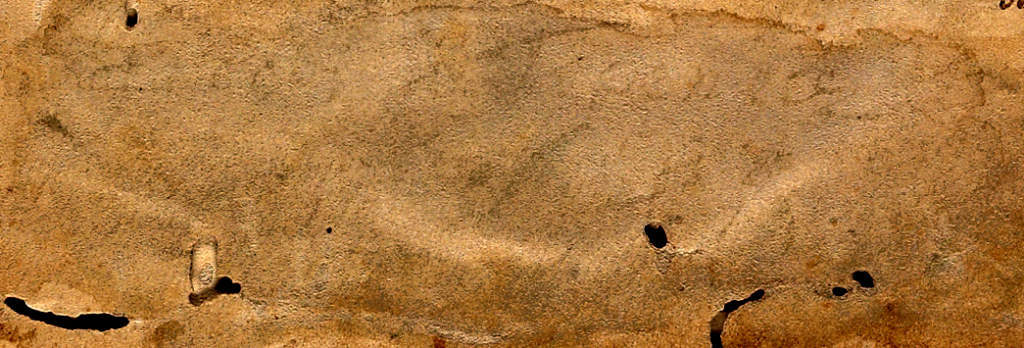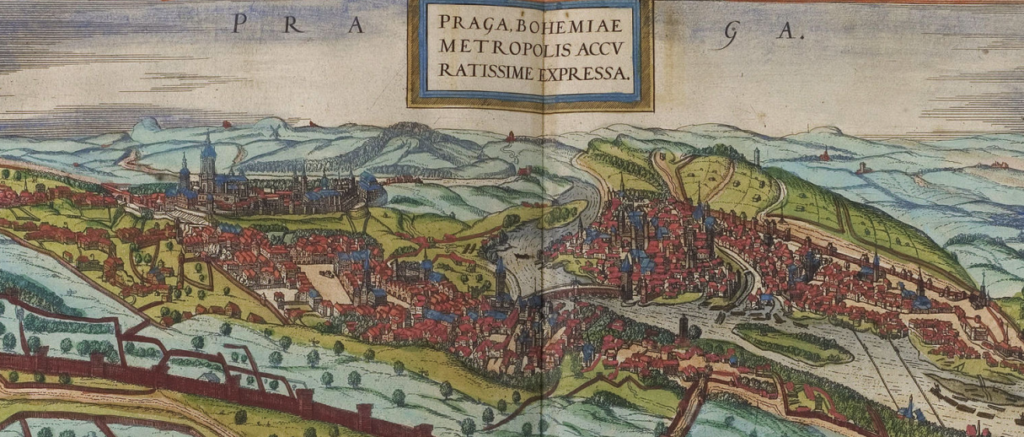I thought readers might enjoy some more background information on Jacobius Sinapius, the Latin name of Jan Jakub Horčický, a Jesuit of uncommon intelligence who rose from poverty to become Emperor Rudolf II’s physician and herbalist. Sinapius (also sometimes written Synapy), came to the attention of Wilfrid Voynich when a faint ghost of an expunged name was seen at the bottom of the first page of the Voynich Manuscript. René Zandbergen has collected samples of books with similar signatures located by various researchers.
The following biographical information is from a variety of sources, but the most important points are from an 1896 book of history in the Stanford library that was microfilmed in 1994 and scanned more recently by Google. Unfortunately, it is in Czech, and I have not studied Slavic languages. I know some German (which is a second language to many Slavs) and a little bit of Russian, but it was a struggle to piece together information that was mostly in Czech.
In Czech history, Sinapius is presented as a promoter and defender of the Catholic faith, which is not central to solving the VMS, so I have selected events of particular interest to Voynich researchers.
Here is a detail of a scan of folio 1r from the Beinecke Library that shows the badly defaced vellum and faint marks of a name or signature Jacobi [á? de?] Tepenecz on the first line. There is possibly some obliterated text on the second line (or bad scratches in the vellum), and some faint marks to the right that may be a catalog number, as suggested by other researchers:
What made me particularly interested in re-visiting Sinapius’s history (which I looked at a few years ago) is the fact that the Ex Libris marks located by other researchers on books apparently from Sinapius’s library have some odd properties. I will describe those in a separate blog after summarizing some of his background.
In the Beginning…
Jan Jakub Horčický was born approx. 1575 to a poor family, in or near the village of Krumlově. Krumlově, now known as Český Krumlov, is a town in southern Bohemia that was ruled by the Rosenbergs in the early 14th century, the time leading up to the creation of the Voynich manuscript. The primary language of Krumlov was German and German became even more dominant when miners and tradesmen moved in to take advantage of local resources. If Jakub’s first language was Czech, then he was part of a minority population.
In the early 1600s, when Sinapius was in his mid-20s, the town was purchased by Emperor Rudolf II, who presented it to his son Julius. German was the primary language of the Holy Roman Empire. Why would this be relevant to Voynich research? Because the German language was expressed with certain scribal conventions that differed from those of Slavic languages.
When he was about 13, Jakub was accepted as a cleaning boy in the kitchen of the local Jesuit institution, which included a school. Someone apparently noticed the boy’s keen intelligence, as he was admitted to classes in 1590 and became associated with the local pharmacy, possibly as an apprentice, under the tutelage of Martin Schaffner, who was a Moravian-born apothecary in his mid-20s who was knowledgeable about herbs and distillation.
In autumn 1598, Jakub traveled to Prague to continue his studies in logic and natural sciences and honed his business skills by collecting, processing, and selling herbal remedies. Some of these herbs were collected in the Jesuit gardens on the slopes of Petřín Hill and at Vltava (below Letenská hill).
In 1600, he moved to Jindřichův castle, in SW Bohemia, to assume responsibilities for the grounds at a sprawling estate that shows many signs of having been remodeled and rebuilt over the centuries. It’s difficult to imagine what it looked like in the 1600s.
Shortly before 1606, he moved again, traveling north to Hradčany, an independent borough of central Prague. The map above illustrates Prague’s topography and vast gardens in the days before the farmland was covered over by buildings and streets. Sinapius apparently had enough idle time during his tenure to experiment with herbal remedies and to become acquainted with the alchemists in Rudolf II’s court.

Prague Castle in 1595, a few years before Sinapius moved there. [Wikipedia image contributed by Joris Hoefnagel]
When the Emperor fell ill in the winter of 1608, and the apothecary cured him of an ailment that other doctors had apparently failed to remedy, the emperor awarded him a coat of arms and the title of Jacob of Tepence (in Czech: Jakubu Horčickému z Tepence). This suggests that the name was added to the Voynich Manuscript sometime after 1608 or 1609.
Change in the Winds…
In 1612 , Emperor Rudolf II died and his younger brother Matthias (1557–1619) took over his title and estates and ejected many of the scientists who filled Rudolf’s court.
After the new régime was established, Sinapius was appointed governor of the royal estate of Mělník, just north of Prague. This appointment was rockier than the previous ones as the people of the region challenged his authority and his religious beliefs. Rudolf II had been religiously tolerant, but it was feared that Matthias would be less so.
For Sinapius, it was a time of general unrest and things became deadly when the Bohemians rose up against Matthias’s Habsburg dynasty. A provisional government was established, Sinapius refused to accept their authority, and was briefly imprisoned. The 30 Years War—a violent confrontation resulting in physical destruction, and millions of lost lives, created a major disruption that the kitchen boy from Krumlov probably never expected to experience in his lifetime. When released from prison, his future was uncertain and he faced possible expulsion.
In 1619, Emperor Matthias died, and two years later SInapius apparently fell from a horse and was injured such that his health failed and he died a year later, in 1622.
Unanswered Questions
Did the VMS belong to Emperor Rudolph, or to Jacob Sinapius? When the emperor died, was the manuscript in Sinapius’s possession?
Emperor Matthias didn’t share his older brother’s passion for alchemy, so he may not have cared about an unreadable book with strange pictures of plants. Would it have mattered to him if Sinapius kept it? Might he have given it to Sinapius? Or might Sinapius have quietly taken it with him when moving from Prague to Mělník and then, realizing his days were numbered, passed it on to his Jesuit brothers before he died?
The correspondence that went back and forth between the Jesuits about the VMS is never very explicit, which makes one wonder if the VMS was contraband. The other reason for the secrecy might have been social taboos against the “black arts”. Anything of an occult nature might be perceived as consorting with the devil. Whatever the reason, I noticed something about the Ex Libris markings that I will discuss in a future blog.
J.K. Petersen
© Copyright 2018, All Rights Reserved



Thanks JKP.
Is the 1896 book the one by Podlaha? In that case I appreciate the reference to the Google scan since I have only a defective PDF of it. (I equally can’t read Czech).
More information related to Tepenec’s biography, and other sources about him, may be found here:
http://www.voynich.nu/curricula.html#sinapius
Finally, the illustration of the Prague castle is from the 17th C artist Joris Hoefnagel. Not sure if that is what you meant.
I had intended to include a link to the scan and forgot to do so before posting.
You can find it here.
I am Czech/English bilingual, would that help?
Welcome Hana. I think Voynich research could really benefit from someone who knows about Czech language and culture.
A few years ago there was a Czech woman who said she had deciphered the VMS and was working on it. Then I never heard anything more about it.